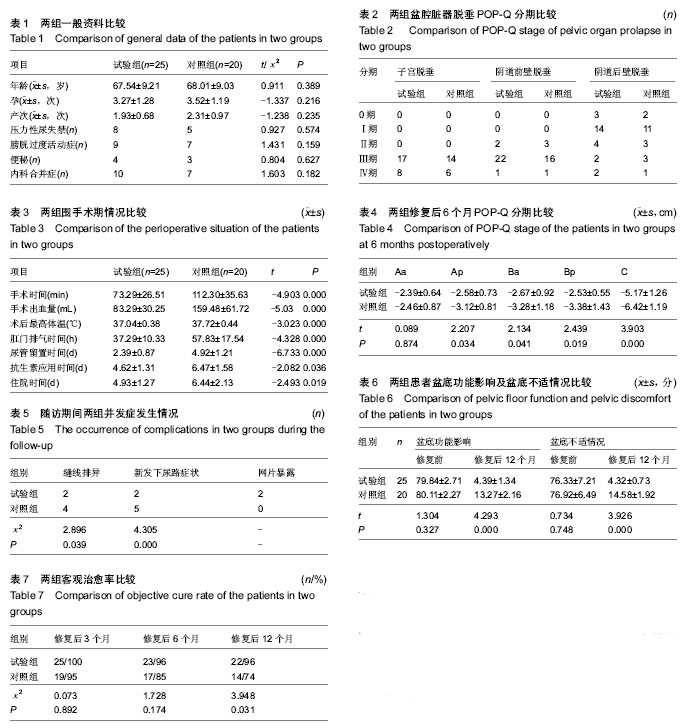中国组织工程研究 ›› 2015, Vol. 19 ›› Issue (12): 1899-1903.doi: 10.3969/j.issn.2095-4344.2015.12.018
• 细胞外基质材料 extracellular matrix materials • 上一篇 下一篇
聚丙烯补片在改良盆底重建修复盆腔脏器脱垂中的应用
谢 虹1,2,黄海伟1,马 新1,赵 芳1,张 琳1
- 1苏州大学医学院附属张家港医院妇科,江苏省张家港市 215600
2张家港市第一人民医院妇科,江苏省张家港市 215600
Improved pelvic floor reconstruction with polypropylene mesh for repair of pelvic organ prolapse
Xie Hong1, 2, Huang Hai-wei1, Ma Xin1, Zhao Fang1, Zhang Lin1
- 1Department of Gynecology, Affiliated Zhangjiagang Hospital of Medical School of Soochow University, Zhangjiagang 215600, Jiangsu Province, China
2Department of Gynecology, the First People’s Hospital of Zhangjiagang, Zhangjiagang 215600, Jiangsu Province, China
摘要:
背景:合成补片是重要的盆底组织替代物,能够替代薄弱受损的盆底筋膜组织,己被广泛应用于盆底薄弱组织的修补重建中。 目的:观察补片在改良盆底重建修复盆腔脏器脱垂的疗效及并发症,探讨其安全性及有效性。 方法:纳入45例女性盆腔脏器脱垂患者,根据患者意愿分两组治疗,试验组25例经阴道植入聚丙烯补片进行改良盆底重建修复,对照组20例采用传统经阴道全子宫切除联合阴道壁修补治疗,记录两组围手术期情况,随访评价两组子宫脱垂分期、并发症、盆底功能及盆底不适情况,以及客观治愈率。 结果与结论:与对照组比较,试验组手术时间短、出血量小、感染轻、恢复快(P均 < 0.05)。随访6个月时,试验组子宫脱垂分期评分高于对照组;随访12个月时,试验组并发症发生率、盆底功能影响评分及盆底不适情况评分均低于对照组(P < 0.05),客观治愈率高于对照组(P < 0.05)。表明采用聚丙烯补片进行盆底重建修复盆腔脏器脱垂具有手术时间短、出血量小、恢复快、裸露率低等特点,同时能显著提高盆底功能,改善盆底不适情况,降低术后并发症的发生,提高客观治愈率,短期随访安全有效。
中图分类号:
